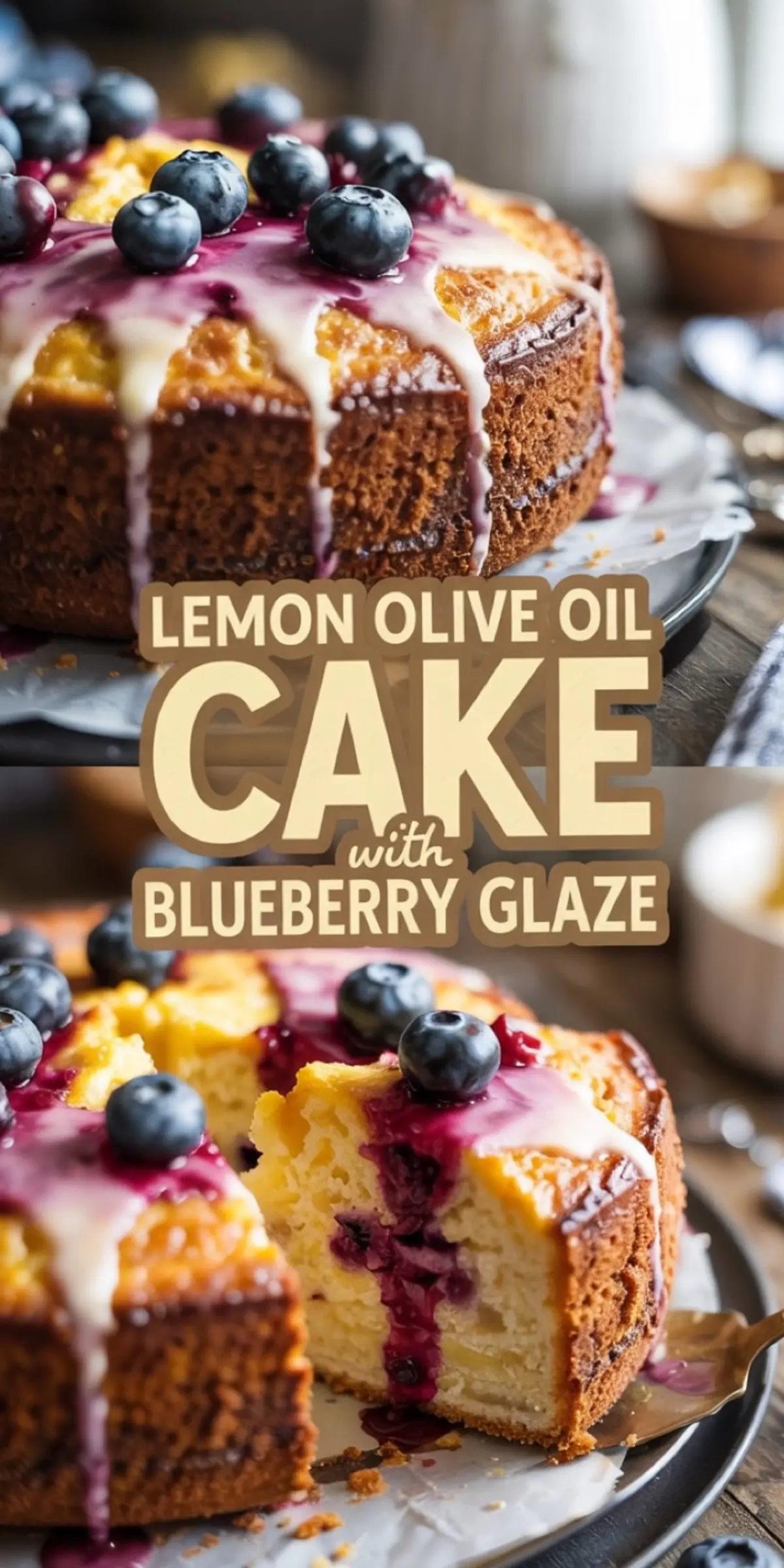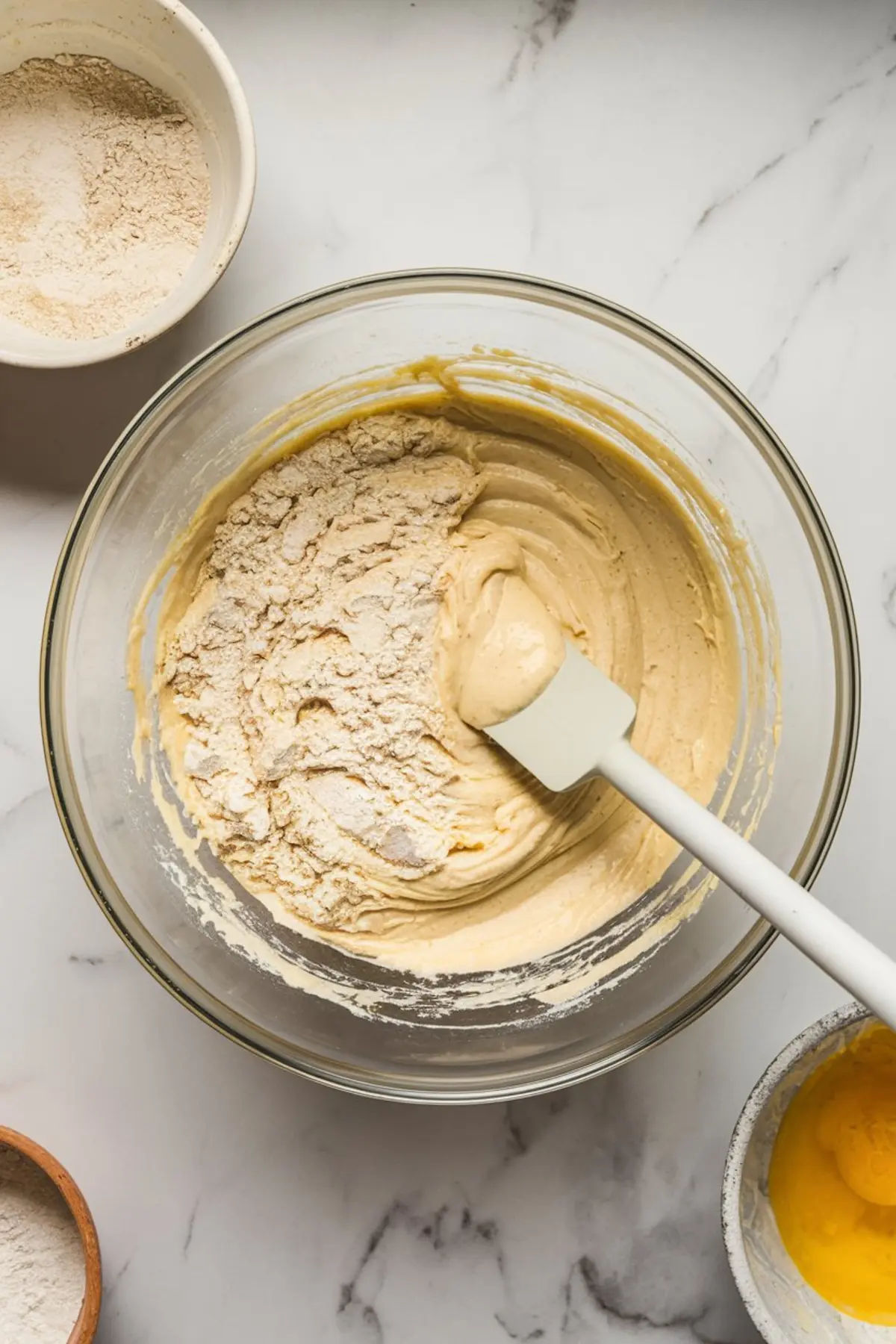You can smell the lemon before you taste it. That’s how you know this cake is going to hit differently.
There’s something grounded about baking with olive oil. It doesn’t try to impress. It just brings quiet richness, a kind of steady depth you don’t get with butter alone. This lemon olive oil cake with blueberry glaze makes that point from the first bite.
You’re going to learn why olive oil belongs in this cake, how to get the most lemon flavor without bitterness, and what actually makes that blueberry glaze work instead of slide off in frustration.
I’ve made this cake more than once. And I keep coming back to it—not just because it’s easy, but because it tastes like it took effort. That balance of tart lemon, jammy blueberries, and the moist crumb olive oil gives? It doesn’t shout. It hums.

Why This Lemon Olive Oil Cake Works for Bakers Who Want Results
This recipe skips anything complicated. You don’t need stand mixers or fancy tools. You whisk, pour, bake, glaze. But what sets it apart is the ingredient balance.

The olive oil gives a plush texture and subtle flavor. You’ll want to use a light, fruity variety—not the peppery type that tastes like you should be drizzling it on steak. I’ve tried it with bith. Trust me, the wrong olive oil makes it weird.

The lemon zest and juice carry all the brightness. But it’s the milk that softens it into something round. Think more cake-shop than lemon bar.

What you get is a golden, tender cake. Moist, but never soggy. Lemon-forward without being sour. The kind of slice you take standing up, then go back for a second while pretending you’re just cleaning the knife.
Getting the Blueberries Right (And Keeping Them From Sinking)
Blueberries are tricky in cake. Use them wrong, and they all slide to the bottom like they’re trying to escape. That’s why you toss them with a bit of flour first. It gives them grip.

Layering them into the batter—half at the start, half at the top—gives even spread. You don’t end up with a blueberry-only base and plain top. I’ve tried just dumping them in before. That’s how I learned better.
The glaze comes later. You’ll simmer fresh or frozen berries with lemon juice and water, then strain it so the texture stays smooth. This step matters. If you skip the straining, the glaze can get chunky and look dull.
You mix that vivid juice with powdered sugar until it runs thick and shiny. Then pour it on after the cake has fully cooled. Otherwise, it just melts off and leaves a purple puddle.
How to Store It (And Why It Tastes Better the Next Day)
Once the cake is glazed, you can keep it at room temp for two days, covered. But I actually like it cold from the fridge on day two. Something about the chill sets the glaze just right and makes the lemon stand out more.
If you want to freeze it, do it before glazing. Wrap it tight in plastic and foil. Then thaw at room temperature and glaze fresh. I’ve frozen slices for up to a month this way and they came out tasting exactly the same.
If the glaze thickens too much after cooling, stir in a drop of water or lemon juice. Go slow—too much and it turns watery.
Serving Tips and What to Pair It With
This cake doesn’t need anything extra, but I like to scatter a few extra blueberries on top and twist some lemon zest curls over the glaze right before serving.
It slices cleanly. Great for brunches, baby showers, or just Thursday. I’ve even packed it up for a picnic once—it held up better than a frosted cake ever could.
You could pair it with black tea, a mild coffee, or something sparkling like lemon soda or Prosecco. But it’s also the kind of cake that stands alone and doesn’t complain about it.
A Cake That Feels Like Summer in a Forkful

I started baking this cake to use up lemons and a bottle of olive oil someone gifted me. I didn’t expect much. But something about that glossy glaze and the way it cut clean made me pause. It felt simple but confident. It reminded me of old Italian cakes I grew up around—just without the fuss.
Every time I make it now, someone asks for the recipe. That’s usually how I know a dessert’s worth sharing online.
This one? It’s worth pinning. Make it your go-to lemon cake. Then come back and tell me how it went.
💬 Share your thoughts in the comments—did you bake it? Swap the blueberries? Want ideas for other glazes? Let’s talk.
📌 Save this recipe to your dessert board so you don’t lose it. It’s one you’ll come back to, trust me.
More Lemon Desserts to Keep the Citrus Love Going
Zesty Lemon Olive Oil Cake with Blueberry Glaze

A bright, citrus-forward cake with a moist crumb and fresh blueberries throughout. Finished with a glossy blueberry glaze, this cake balances rich olive oil with tart fruit flavor. It’s simple to make and visually striking once glazed and garnished.
Ingredients
- FOR THE CAKE
- 1 ½ cups (190g) all-purpose flour
- 2 tsp baking powder
- ¼ tsp fine sea salt
- 3 large eggs
- 1 cup (200g) granulated sugar
- ½ cup (120ml) extra virgin olive oil
- ½ cup (120ml) whole milk
- Zest of 2 lemons
- ¼ cup fresh lemon juice (about 2 lemons)
- 1 tsp vanilla extract
- 1 cup fresh blueberries + 1 tsp flour (for tossing)
- FOR THE BLUEBERRY GLAZE
- 1 cup fresh or frozen blueberries
- 2 tbsp lemon juice
- 1 tbsp water
- 1 cup powdered sugar, sifted
- OPTIONAL TOPPINGS
- Extra fresh blueberries for garnish
- Thin lemon slices or zest curls
Instructions
- PREPARE THE OVEN AND PAN: Preheat the oven to 350°F (175°C). Grease a 9-inch round cake pan with high sides and line the bottom with parchment paper. Set aside.
- MIX THE DRY INGREDIENTS: In a medium bowl, whisk together the all-purpose flour, baking powder, and salt until evenly combined. Set aside.
- BEAT THE WET INGREDIENTS: In a large mixing bowl, whisk the eggs and granulated sugar until pale and slightly thickened. Add the olive oil, milk, lemon zest, lemon juice, and vanilla extract. Stir until smooth and fully combined.
- COMBINE WET AND DRY INGREDIENTS: Add the dry ingredients to the wet mixture and fold gently using a spatula or whisk. Mix just until no streaks of flour remain; do not overmix to keep the crumb tender.
- ADD THE BLUEBERRIES: Toss the blueberries with 1 teaspoon of flour to help prevent them from sinking. Pour half the batter into the prepared pan and scatter half of the floured blueberries on top. Add the remaining batter and top with the remaining blueberries, distributing them evenly.
- BAKE THE CAKE: Bake for 40 to 45 minutes, or until a toothpick inserted in the center comes out clean. The top should be golden and spring back when lightly touched. Allow the cake to cool in the pan for 10 minutes before transferring to a wire rack to cool completely.
- MAKE THE BLUEBERRY GLAZE: In a small saucepan, combine the blueberries, lemon juice, and water. Cook over medium heat for 5 to 7 minutes, or until the berries burst and release their juices. Strain through a fine mesh sieve to remove the skins, pressing to extract as much liquid as possible. Whisk the warm blueberry juice into the sifted powdered sugar until smooth and pourable.
- GLAZE AND GARNISH: Once the cake is fully cooled, spoon or pour the glaze over the top, letting it drip down the sides. Use a spoon to guide the glaze for even coverage if desired. Garnish with fresh blueberries and lemon zest curls or slices just before serving.
Notes
For best flavor and texture, use high-quality extra virgin olive oil with a mild, fruity profile—avoid overly bitter or peppery varieties, as they can overpower the lemon. Whole milk adds richness and a soft crumb, but you can substitute 2% milk if needed, though the cake may be slightly less tender. Fresh lemon juice is essential for a clean, bright flavor—bottled juice will not give the same result. Zest the lemons before juicing to make the process easier and avoid zesting too deeply into the bitter white pith.
Tossing the blueberries in flour helps suspend them in the batter during baking, reducing the chance they’ll sink to the bottom. Layering them between the batter also distributes the fruit more evenly throughout the cake. If using frozen blueberries in the batter, do not thaw them before adding—this prevents excess moisture and streaking.
For the glaze, straining the blueberry mixture is optional but recommended for a smooth finish. If you prefer a more rustic glaze with bits of blueberry skin, you can skip this step. Adjust the consistency of the glaze by adding more lemon juice (for a thinner glaze) or powdered sugar (for a thicker glaze). It should be pourable but thick enough to coat the back of a spoon.
Allow the cake to cool completely before glazing to prevent the glaze from melting and running off. If the glaze thickens too much as it cools, you can loosen it with a few drops of water or lemon juice. For a clean presentation, place the cake on a wire rack over a tray when glazing to catch any drips.
Store the finished cake at room temperature in an airtight container for up to two days, or refrigerate for up to five days. Bring to room temperature before serving for best texture. The glaze may slightly firm up in the fridge but will soften again once the cake is out. This cake also freezes well (without the glaze) for up to one month; wrap tightly in plastic wrap and foil before freezing. Let thaw at room temperature, then glaze just before serving.
Nutrition Information
Yield
10Serving Size
1Amount Per Serving Calories 210Total Fat 4gSaturated Fat 1gTrans Fat 0gUnsaturated Fat 3gCholesterol 62mgSodium 203mgCarbohydrates 40gFiber 2gSugar 21gProtein 5g

